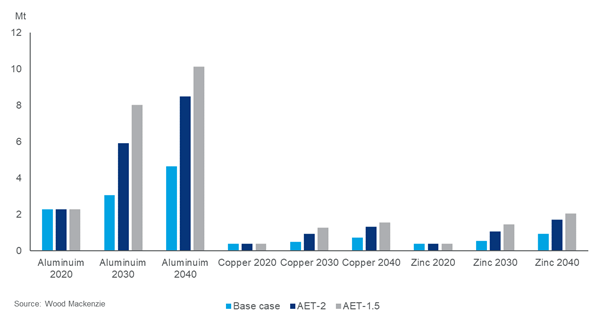Wlazly said that reductions in solar power installation costs due to falling production costs and efficiency gains are likely to prompt a rise in solar’s share of power supply, which may start to displace other forms of generation. In his view, this scenario presents an opportunity for the base metals sector.
“In Wood Mackenzie’s base-case scenario, which is broadly consistent with a 2.8-3˚C global warming view, aluminum demand from solar technologies sits at around 2.4 million tonnes for 2020. This is expected to rise to 4.6 Mt by 2040,” the report reads. “However, under Wood Mackenzie’s proprietary Accelerated Energy Transition-2 (AET-2) and Accelerated Energy Transition-1.5 (AET-1.5) scenarios, consumption growth will range from 8.5 Mt to 10 Mt by 2040.”

Putting the numbers into perspective, the document presents some percentage figures and points out that in the AET-1.5 scenario, demand from the solar sector would increase from just under 3% of total aluminum consumption in 2020 to a considerable 12.6% in 2040.
According to the review, copper consumption is also expected to register notable gains from solar power generation, particularly photovoltaic systems. In the base case scenario, copper demand from solar goes from 0.4 Mt in 2020 and rises to almost 0.7 Mt by 2040. Yet, under the AET-2 and AET-1.5 scenarios, consumption of the red metal from solar is expected to increase to around 1.3 Mt and 1.6 Mt, respectively, by 2040.
When it comes to zinc, demand is also expected to soar as in large-scale solar power plants estimated to have a workable life of at least 30 years, only zinc coatings can offer low-cost corrosion protection for such lengthy periods.
Wood Mackenzie estimates that solar power installations currently account for approximately 0.4 Mt of global zinc consumption, but this number is projected to grow to 0.8 Mt by 2040 in the base case. Under the AET-2 and AET-1.5 scenarios, on the other hand, consumption growth will range from 1.7 Mt to 2.1 Mt, respectively, by 2040.
The risks
As each of WoodMac’s scenarios contemplate the opportunities that increased solar power consumption may have on base metals, they also present the risks.
For Wlazly, even though there is potential in concentrating solar power plants switching from steel to aluminum-based design in the elevation structures and collectors, it is important to consider that steel will always have a cost advantage in applications where weight is not an issue. This means that the degree of substitution remains uncertain.
WoodMac’s expert also sees a possibility of the aluminum sector taking advantage of the rising price of copper as it may start penetrating wire and cable applications in installations where copper is currently the favoured metal choice.
Similarly, aluminum may benefit from the trend towards manufacturing larger solar modules because as the devices’ surface and tracker area increase, it is likely that the use of structural components will scale at a similar rate to maintain strength and rigidity. This means that the use of aluminum and zinc (galvanized steel) per module will increase, leaving the intensity broadly unchanged.
“In contrast, the use of copper is expected to decline as larger modules will cause a reduction in the number of panels per given capacity of the plant, resulting in a drop in the overall number and length of cables,” the report states. “However, the overall decline in intensity will be marginal as panel size will not affect the diameter of the cable or transformer, both of which account for a significant proportion of copper use. Additionally, the impact on metal demand by the increase in module size will be limited to utility-scale solar plants, which currently only account for a third of installed capacity.”




